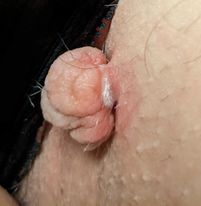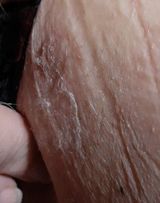Example of an extremely large skin tag successfully treated at The Hub.
Definition of Cryotherapy
It is the use of cold and freezing techniques to treat the body, using extreme cold to cause controlled destruction of unwanted tissue in a precise application by use of liquified N20 to deliver quick, effective cryo-therapy treatments to benign skin lesions. The N20 destroys tissue by freezing intercellular fluid and forming ice shards and crystals that rupture the cells membrane, destroying the cell.
Because it delivers N20 onto the lesion and not healthy surrounding tissue it can treat lesions on the face and around the delicate eye area, accurately delivering ultra-cold, High pressure N20 jet directly onto the lesion, making it very effective. It is very fast, with a penetration of 1mm per 5 seconds and is able to penetrate to a depth of 5mm
Cryotherapy is an ideal solution for various skin conditions that you might seek treatment for, these include,
- Skin tags from £30.00 usually 1 treatment (depending on size)
- Age spots /sunspots usually one treatment from £30.00 (depending on size)
- Cherry Angioma (blood spots) usually one treatment from £30.00
- Millia (millium) usually one treatment from £30.00
- Warts and verrucae from £50.00 more than one treatment may/will be needed
Unsure what you may have please call or book online for a consultation
If I am unsure or have any doubt regarding a skin lesion, I will refer you back to your GP for a diagnosis. If they say that it can be removed, and you get that in a written form I will happily carry out the treatment.
Cryotherapy is the name given to treatments involving liquid nitrogen spray. Liquid nitrogen spray freezes skin and tissues. The result is a very localised area of frostbite. This is a means of treating warts and other skin conditions. Just like frostbite, cryotherapy can sting a little. For some of our treatments we will spray N20 from 4 to 30 seconds depending on what type of benign skin imperfection we are treating (a verrucae will need longer treatment time than an age spot). Immediately afterwards, it may look as if nothing has happened. However, the treated area may blister and become painful over the following days. This is quite normal and expected and is a direct result of freezing. Just like any other blister, if it breaks it may become infected, so it is important to keep any broken blisters clean. Apart from that you can wash as normal and, provided you do not have any broken blisters, you do not need a dressing. The blister will eventually shrivel and be replaced by a scab, which can take a week or two to come away, leaving a small area of pink healed skin which will eventually fade over the next few weeks. Be patient–nature takes it time. If you are in doubt about the healing process, please ask us.
Depending on the lesion treated, you may need repeated cryotherapy after a few weeks. Because the procedure can be uncomfortable, we prefer not to perform cryotherapy on small children. It is very unlikely that you will develop complications. The commonest complication after cryotherapy is Infection although this is unusual, but sometimes unavoidable. Symptoms of infection are increasing pain and redness. There may be a yellow, foul-smelling discharge. If this happens or you are in anyway concerned, you should contact The Hub for advice (we may ask you to attend The Hub so that we can take a look at the wound). In most cases no scarring results from the treatment, although there may be some change in the colour of the skin in the treated area. You must wear a SPF 30 after treatment.
Each visit will require a consultation where you will be asked a few medical heath questions. We will photo graph the lesion and measure for our records. Consent forms have to be signed prior to any treatment.
What does the procedure involve?
The procedure itself only lasts a couple of seconds; the precise time depending on the thickness and size of the lesion. The frozen skin becomes white and takes one to two minutes to thaw to normal skin temperature. The process is repeated once the skin has thawed out.
Over the proceeding few days a scab will form, and this will take one to two weeks (and occasionally a little longer, especially on the legs) to come away.
Depending on the nature of the lesion, more than one treatment may be necessary, and this is usually repeated at regular intervals.
How should the treated area be cared for.?
It is usually suggested that the treated area be kept dry for 24 hours
It is important not to pick at the scab, as this will encourage scarring. A dressing or a plaster is not usually necessary or may be advisable if the treated area is prone to being traumatized or rubbed by clothing.
What are the side effects of this treatment?
Immediate side effects.
- Pain – cryotherapy is usually well-tolerated but can sometimes be painful if a deep freeze has been necessary. This discomfort can occur both at the time of treatment and for a variable time afterwards.
- Swelling and redness – this is a normal immediate response to freezing the skin, and usually settles after two to three days. For a short while the treated area may ooze a little. Cryotherapy close to the eyes may induce prominent puffiness of the lower eyelids which settles within days.
- Blistering – some people blister more easily than others and the development of blister does not necessarily mean that the skin has been frozen too much, occasionally the blister may become filled with blood; this is harmless and only if a blister was very uncomfortable would it be necessary to puncture it, using a sterile needle. Any punctured blisters should be covered with a dressing to avoid infection.
- Infection – uncommonly, infection can occur, resulting in increased pain and the formation of pus; this may require topical antiseptic or antibiotic therapy
Subsequent side effects
- Scarring – rarely a scar will form, especially if a deep freeze has been necessary.
- Pigmentation changes– the skin at and around the treatment site may lighten or darken in colour, especially in dark skin people. This usually improves with time but may be permanent.
- Numbness – if a superficial nerve is frozen, it may result in numbness of the area of skin supplied by that nerve. Normal feeling usually returns in a matter of months.
- Treatment may not be effective, or the condition may recur
I am qualified and insured to carry out this treatment.
Caroline Murphy



